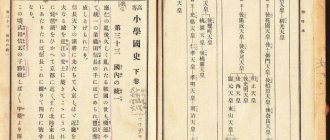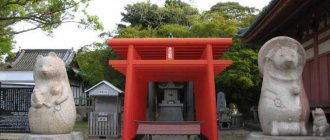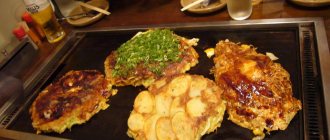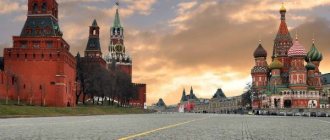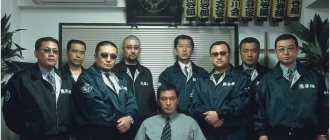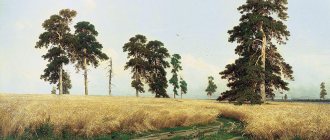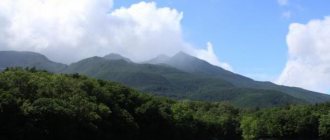Honshu
Honshu is the largest island of the Japanese archipelago, its area is about 60% of the area of the entire country. The length of the island is 1300 kilometers, the width ranges from 230 to 50 kilometers. The length of the coastline is 5450 km. The island of Honshu is slightly smaller than the island of Great Britain (British Isles).
More than 100,000,000 people permanently live on Honshu, which is about 80% of the state's residents. It is the most populous of Japan's four main islands. Major Japanese cities such as Tokyo, Osaka, Hiroshima, Kyoto, and Yokohama are located here.
The island of Honshu also has other names - Hondo and Nippon, which are now rarely used.
The island's terrain is mountainous, with many volcanoes among the mountains. The largest of them is Mount Fuji (3.776 m), which is a symbol of Japan. Thanks to her, Honshu ranks 7th among the highest islands in the world. The island experiences frequent earthquakes as it lies at the junction of 3 formation plates.
The climate of Honshu is very diverse - from continental in the north to subtropical in the south. There are very noticeable differences in the climate of the southeastern (Pacific Ocean) and northwestern (Sea of Japan) parts of the island. This is explained by the fact that they are separated from each other by mountains.
Sado
The rocky coves, cliffs and emerald waters along the shores of Sado Island make for a stunning spot for kayaking or diving. At the same time, the coastline is no less impressive than the cedar forests in the interior of the island.
Photo: (CC BY-SA 3.0)
Photo: (CC BY-SA 3.0)
Photo: (CC BY-SA 3.0)
Hokkaido
Hokkaido Island is the second largest island of Japan. It is separated from Honshu by the Sangar Strait. The Seikan Tunnel is built under the seabed between these islands.
The island of Hokkaido was in the past known as Ezo, in the old Russian transcription Ieddo, Iesso. Until 1859, it was also called Matsumae (in the old Russian transcription - Matsmay, Matsmay) after the surname of the ruling feudal clan, which owned the castle town of Matsumae.
In total, about 5.5 million people live on the island; famous cities in Japan include Sapporo, Chitose, and Wakkanai.
The largest city of Hokkaido and the administrative center of the prefecture of the same name is Sapporo.
The territory of Hokkaido is almost equally divided between mountains and plains. Moreover, the mountains are located in the center of the island and stretch in ridges from north to south. The highest peak is Mount Asahi (2290 m).
The easternmost point of Japan is located on the island - Cape Nosappu-Saki.
The climate on this island is noticeably colder than in other areas of Japan. Due to the proximity of the Pacific Ocean, the island experiences an average of only 17 full sunny days per year, with an average of 149 rainy days in summer and 123 snowy days in winter. The average annual temperature in Hokkaido is only +8 °C. And although geographically most of the settlements are located south of Paris, the climate is very different from European.
The island of Hokkaido is mostly covered with forests. Coniferous forests of spruce and fir predominate, with dense thickets of bamboo in the undergrowth. At the heights there are forests of cedar and birch, and there are heathlands with shrubs. In the south of the island, the forests consist of broad-leaved trees.
In the forests you can find brown bear, fox, sable, ermine, and weasel.
Japan from North to South
JAPAN
, an island state in the northwestern Pacific Ocean, located off the coast of East Asia, occupies four large islands - Honshu (3/5 of the country's area), Hokkaido, Shikoku and Kyushu - and many small islands stretching in an arc of about 3500 km from Hokkaido in the northeast to the Ryukyu Islands in the southwest.
Hokkaido
Also known in the past as Ezo, Ieddo, Iesso, Matsumae. The second largest island of Japan, separated from Honshu by the Sangar Strait. In total, about 5.5 million people live here; famous cities include Sapporo, Chitose, and Wakkanai. Since the climate on this island is noticeably colder than in the rest of the country, among the Japanese themselves, Hokkaido is considered a “harsh server”. Despite the fact that geographically most of the settlements are located south of Paris, the climate is very different from European. About 10% of the island's area is occupied by more than 20 national parks, making it a recognized center for active tourism in the country. Hokkaido is a good alternative for those who have had enough of the many temples in the older parts of Japan. A trip to picturesque, often wild and almost untouched by civilization places or a relaxing stay at one of the many thermal resorts will be very pleasant, especially during the hot summer months.
Honshu
The largest island of the Japanese archipelago, previously also known by such names as Hondo and Nippon, accounting for 60% of the area of the entire country. The length of the island is 1300 kilometers, the width ranges from 50 to 230 kilometers. About 100,000,000 people live permanently on Honshu. Major cities such as Tokyo, Osaka, Hiroshima, Kyoto, Yokohama are located here. The symbol of Japan is Mount Fuji, also located on Honshu. The volcano is located in the Fuji-Hakone-Izu National Park, which includes the forested volcanic region of Hakone and the ice-free crater Lake Ashi, on the shores of which stand the “tori” of the Hakone Temple. "Tori" - ritual gates in front of the sanctuaries; they are very characteristic of Honshu, and are found everywhere here. Tory is easy to spot; they are traditionally painted bright red. As a rule, each temple has several tori. The Fushimi Inari Shrine in Kyoto, the main shrine to the goddess of rice and abundance, Inari, is home to several thousand tori. According to Japanese belief, those who succeed in business are obliged to donate to the tori shrine. But the most famous tori stand in the Itsukushima Shrine - one of the main attractions of Honshu and an easily recognizable symbol of all of Japan, included in the UNESCO World Heritage List. The tori was built from camphor wood in 1875, its height is 16 m, and at high tide the gates are submerged in water. The sanctuary itself in its current form was built in the 16th century, and is officially considered a “national treasure” of Japan.
Shikoku
The fourth largest Japanese island, home to about 4 million people. Most of the major cities and population are concentrated in the northern part of Shikoku. The most famous cities include Matsuyama, Tokushima, Kochi, Takamatsu. Shikoku is known throughout the world for its 88 pilgrimage temples, which are associated with the activities of the legendary Buddhist monk Kukai. For tourists, the island of Shikoku is interesting because there are a large number of Shinto and Buddhist temples and monasteries on its territory. This is a place of mass pilgrimage for the Japanese and a favorite place for foreign tourists who want to join the religion of the Japanese people.
Kyushu
The third largest island of Japan, according to some sources, considered the birthplace of Japanese civilization. Currently, there are such large cities as Fukuoka, Nagasaki, Hirado, Oita, Kagoshima and Kumamoto, the total population of Kyushu is about 12 million people. Among other things, Kyushu boasts numerous pottery villages, in particular located around Karatsu and Arita; and coastal Beppu with its hot springs. The southern cities of Kagoshima and Miyazaki are known for their mild climate and the quality of the strong drink, shochu. The Miyazaki region is also considered the mythical home of the sun goddess Amaterasu, who took refuge on the island of Kyushu, hiding in a remote cave, and plunged the world into darkness. It was only after her divine brethren lured her away that light and warmth returned to the Earth and to the land of the rising sun.
Ryukyu Islands
The Ryukyu Islands are a group of 98 islands stretching 1,200 kilometers in the East China Sea from Kyushu to Taiwan and having a total area of 4,700 square meters. km. The total number of inhabitants is 1.6 million people, 90% of whom live on the largest island - Okinawa. The nature of the islands is rich and colorful: the slopes of the mountains of the southern islands are covered with tropical forests with palm trees and orchids; on the northern islands there are forests of camellias, magnolias, camphor laurel, and oak. The favorable tropical climate contributes to successful agriculture: rice, sweet potatoes, sugar cane, and pineapples are grown on the islands. Intensive fishing is carried out in coastal waters. Located at the same latitude as Miami and the Bahamas, Okinawa Prefecture, with an average annual temperature of +24 C, is famous for its coral islands, year-round blooming hibiscus and turquoise-blue sea. Transparent water off Okinawa can be seen up to 40-50 meters. Sunlight, penetrating into the depths, creates favorable conditions for the growth of coral reefs - the hardened remains of corals that live in huge colonies and determine the underwater landscape of the entire archipelago chain. The largest coral reef in Japan, up to 20 km long, is located off the coast of Okinawa. Every year, divers come to the island to observe the coral thickets and their inhabitants.
Kyushu
Kyushu Island is the third largest island in Japan. The area is approximately 35.6 thousand km². Population: about 15 million people. According to some sources, it is considered the birthplace of Japanese civilization. In the old Russian transcription it was called Kiu-Shiu or Kiu-Siu.
Major Japanese cities such as Fukuoka, Nagasaki, Hirado, Kagoshima, Oita and Kumamoto are located here.
Kyushu Island is connected to Honshu Island by the Kammon Tunnel (road and rail), built under the Shimonoseki Strait (Kammon Strait).
The terrain is mountainous (plains are common only in the west and north-west of Kyushu). The highest point is the inactive Kuju volcano (1788 m).
Kyushu Island is classified as a seismic zone. One of the most active Japanese volcanoes, Aso (1592 m), is located here; The volcanoes Sakurajima and Kirishima are also active. There are numerous thermal springs on the island.
The shores of Kyushu are heavily indented (except for the eastern ones). The climate is subtropical, monsoon; typhoons are frequent. Kyushu is washed by two warm currents - the Kuroshio and the Tsushima. In the south there are tropical monsoon forests dominated by palms and ferns.
Who does it border with?
Examining the photo map of the world, it is easy to discover that Japan has no land borders, and the total length of the coastline is 29.8 thousand km. The country's special economic zone extends 200 nautical miles from the coast; the territorial sea includes up to 12 nautical miles; for international straits the distance is slightly less.
It is also noticeable on the political map of the world that Japan borders by sea with countries such as Russia, China and the Republic of Korea. Japan has unresolved issues with each of its neighbors regarding disputed territories. In particular, with Russia this is an issue regarding the ownership of the islands that are part of the Kuril Islands. These are the southern Kuril Islands - Shikotan, Habamai, Iturup and Kunashir.
Shikoku
Shikoku Island is the fourth largest island in Japan and is home to about 4 million people. Throughout the world, Shikoku is known for its 88 pilgrimage temples, the appearance of which is associated with the activities of the legendary Buddhist monk Kukai.
Most of the major cities and population are concentrated in the northern part of Shikoku. Among the most famous cities are Matsuyama, Tokushima, Takamatsu, Kochi.
On the island of Shikoku, the problem of population aging is more pressing than anywhere else in Japan, since young people are actively leaving for Tokyo, Osaka and other major cities in Japan.
In ancient times it was called Iyo-no-futana-shima, Iyo-shima and Futana-shima. In the old Russian spelling, the modern name of the island sounded like Shikok, Shikoku, Shi-Koku.
The island regularly hosts the Shikoku EV Rallye. Shikoku is connected to the island of Honshu by a highway that includes the Akashi-Kaikyo Bridge.
Small islands
General information about the country
Japan is an interesting and mysterious country with a special climate, traditions and absolutely stunning, sometimes fantastic, objects.
Climatic conditions
Japan has a fairly large territory, and the climate in its vast expanses is divided into several zones :
- on the northern islands, including Hokkaido;
- in the center (Honshu Island) – moderate;
- The southern islands (Kyushu and northern Ryukyu) have a subtropical climate.
Such differences are easily explained - the country has a significant extent .
Honshu is the third largest island in Asia. Read here which peninsulas and islands are the largest in the world.
Winter in the country is quite cold - in the north the air temperature reaches -25°C, in the center -10°C. Snow drifts are so high that residents of the northern islands turn snow hills into “ganges” - snow tunnels. It is noticeably warmer in the south of Japan - in this region in winter the thermometer shows +17°C, and throughout the entire season it is dry and warm.
Summer on the islands is hot, humid and rainy. The daytime temperature in the hottest month is up to +30°C, and at night it barely drops to +23°C. During this period, the wet rainy season , accompanied by typhoons and tsunamis. The water in the sea reaches +27°C, and in the ocean +20°C.
Internal organization
Japan is one of the countries where traditions are honored and observed since ancient times. From its founding to the present day, the state has been headed by the imperial dynasty . Formally, the ruler is the Emperor, but in fact - the prime minister - the head of the cabinet of ministers.
According to the Constitution, the Emperor of Japan is the symbol of the state and the Japanese nation. Despite this, he has rights including:
- awards ; _
- departure of ceremonies ;
- communication with foreign representatives ;
- confirmation of amnesties ;
- mitigation of punishments ;
- restoration of rights .
population is 127 million people, while life expectancy is quite high - 80 years for men, 86 years for women.
Due to this, the annual population growth is increasing to a large extent.
The main ethnic composition of the country (99%) is Japanese ; in addition, the state is home to Chinese, Filipinos, Koreans and Ainu.
The vast majority of the country's residents speak their native language - Japanese, which is also the national language of Japan. Its writing was formed against the background of different language families, but family ties have not yet been clarified. It is assumed that Altai and Austronesian parallels are mainly traced.
There are three main religions in Japan, the main one being Shintoism . This belief has ancient roots, and the sources of its origin have not yet been found. For the Japanese, this belief has become not only a religion, but also a part of tradition, history and life itself.
The essence of Shinto is that the Japanese nation is of divine origin. According to the scriptures, the emperor (mikado) appeared first, followed by the Japanese themselves (kami). It is for this reason that the essence of Shinto is ancestor worship .
Airports
The main way to get to this country is by air - a fast and safe option. International airports are located on several islands, in particular on Hokkaido, Honshu, and Ryukyu. They are built near the center of large cities, and can be reached by high-tech trains.
Japan has three Ferris wheels that are more than 110 meters high. And in this article, you will find out which countries are breaking records in this category.
The largest known airports in Japan:
- Haneda is the largest and oldest airport terminal within Tokyo;
- Narita is an equally large and modern airport in Tokyo, built to replace Haneda;
- Kansai is an air terminal built right in the middle of the water on an artificial island in Osaka;
- Chubu is another major air terminal on an artificial island, from where passengers are transported to land by high-speed ferries, trains and buses.
Other large air terminals are located in famous cities - Osaka - the business center of Japan, Kyoto, Nagasaki and Kitakyushu.
Sea ports
You can also get to Japan by ship - the most important maritime transport, which plays an invaluable role for the country. 1020 sea gates in the vastness of the state . They all differ in purpose and activity.
About 100 of them have the role of a main port, 22 are for special purposes, 892 are for local purposes.
The most famous and largest ports:
- Nagoya is the main maritime hub focused on international transport;
- Yokkaichi is a port for oil transport, capable of receiving up to 300 tons;
- Tokyo - a marine terminal for receiving various types of cargo and a place for ship repairs;
- Yokohama is the largest water area with 166 berths for the import of coal, timber, cement and seafood, cars and chemical products;
- Kitakushi is a key port for shipping goods to Shanghai, Seoul, Tokyo and Dalian.
The largest container port is the Port of Kobe - a gigantic equipped port capable of receiving up to 250 large ships.
Southern Islands
The Southern Islands of Japan usually include the Ryukyu Islands, located to the southwest of the main part of the country, the Bonin Islands, located in the Pacific Ocean, at a distance of 1000 km from Tokyo, and the most remote island of Minamitori.
The Ryukyu Islands are a group of 98 islands in the East China Sea, stretching 1,200 kilometers from Kyushu to Taiwan. The total number of inhabitants is 1.6 million people, the total area is 4700 square meters. km. 90% of the islands' inhabitants live on the largest island, Okinawa. Currently, only 47 islands have a permanent population. The most developed sectors of the economy are fishing, agriculture and tourism.
The Bonin Islands are a group of 41 islands located south of Tokyo between the Mariana Islands and Japan. The total population is about 2,500 people, the total area does not exceed 104 square kilometers.
Minamitori is the easternmost island that belonged to Japan.
It is located 1848 km southeast of Tokyo and 1267 km east of the nearest Japanese island. Minamitori has an area of 1.2 square kilometers and has no permanent population. Despite this, the island is of extreme strategic importance, allowing Japan to claim 428,875 km² in surrounding waters.
Cat Islands - Aoshima and Tashirojima
Since the majority of the population of the two Japanese islands - Aoshima and Tashirojima - are cats, they were given the appropriate nickname - “Cat Islands”. The people who live on these islands believe that cats bring them luck and wealth. And Tashirojima even has a small cat shrine (Neko-jinja) and 51 cat monuments. Dogs, by the way, are prohibited from visiting these islands.
Origin and location
According to one of the beautiful legends, the Japanese islands appeared from the tears of the goddess Izanagi. From the place where the tear dripped into the Pacific Ocean, an island grew. However, geology presents the origins of Japan in a less poetic way. Scientists claim that the islands appeared from lava erupted by local volcanoes and the movements of tectonic plates.
The islands are located on a layered volcanic archipelago in the northwest Pacific Ocean. Thanks to this location, Japan boasts one of the most beautiful landscapes. In some places it is mountainous terrain with snow-capped peaks, in some places it is tropical. And, of course, the ubiquitous 29,000 km long coastline.
Interesting! The Japanese are incredibly lucky: the islands are scattered in that part of the Pacific Ocean where the Kuroshio Current dominates. It carries warm currents from the South and East China Seas to northern latitudes, creating a mild and tropical climate. The islands of Shikoku, Honshu and Kyushu are especially susceptible to its influence.
Ryukyu Archipelago
Once upon a time, or rather in the 15th century, the Kingdom of Ryukyu was an independent state. But later, after being captured by the Satsuma clan, the country came under the subordination of Japan. After this, almost 200 years later, territorial reform was introduced on the territory of the Land of the Rising Sun (during the Meiji era), from that moment, “clans” became “prefectures”. These events also influenced the fate of the Kingdom, as a result of which, a few years later, the Ryukyu Kingdom ceased to officially exist, and Okinawa Prefecture appeared, which we know to this day.
The island of Okinawa, not typical for Japan, delights tourists with its turquoise sea, hot climate and wonderful cuisine. Okinawa is like the Japanese “Hawaii”, heavenly climate, white sand, amazing sea. And of course, amazing delicacies and other goodies of Japanese cuisine. Every year many tourists come here.
What else is Okinawa rich in?
- Fabulous coral reefs
- Mysterious caves
- Snow-white clean beaches
- Amazing architectural
- Enchanting nature
- Beautiful ceramics and textiles
- And there is also some kind of music here. Melodious and beautiful. Listening to it, you can enjoy the sunset and enjoy life.
There is a particularly interesting place on the island - the Ancient Ryukyu amusement park. If you want to touch the history of the island yourself, then come here. Here you will be dressed in a kimono and given the opportunity to try ancient crafts. You can imagine yourself as a weaver or potter. Eat national dishes and listen to funny songs.
Popular cities
All cities are interesting to tourists; in each you can find interesting sights. But most tourists start their trip from the capital. It is in Tokyo that everything that attracts many travelers is concentrated. Huge transport interchanges, unprecedented skyscrapers that create futuristic landscapes.
The Imperial Palace, suburbs that have preserved the charm of antiquity. This city has an incredible fusion of history and modern culture. There is a whole area for gourmets - Ginza. History buffs will also find a place to hang out. Anime culture attracts special attention.
The historical center of Asakusa is definitely worth a visit here.
Kyoto, the former capital of the state, is also loved by tourists. Here is the most famous geisha quarter.
This city is also the center of religious buildings - there are more than one and a half thousand Buddhist temples and about 400 Shinto temples.
If you are interested in modern architecture and the bustling life of the city, then you must visit Yokohama.
Amusement parks and skyscrapers can provide an unforgettable experience.
Without a doubt, you should not go on a trip without at least a short guide to Japan in Russian or English, if you know it perfectly. Often such reference books show a map of the world, indicate where the state being described is located, and much more.


